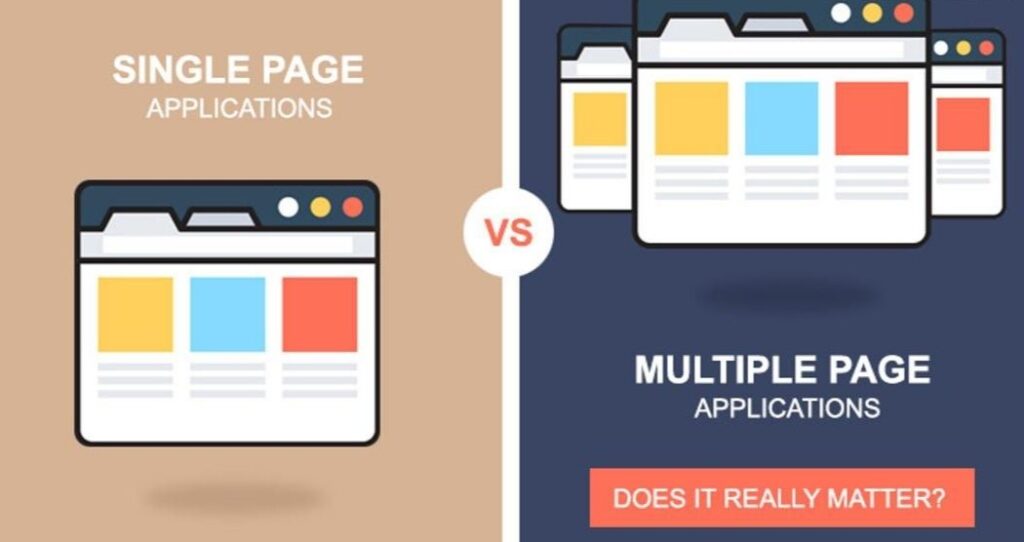Table of Contents
Web applications are still in demand for many users. Besides, more people tend to download and use mobile apps on the go because it is incredibly convenient. As to the web apps, their number also keeps growing since they offer a better user experience. They are also accessible from any device like any mobile application. Today there are two key types of web applications – single-page application and multi-page application. They have something in common but offer different features and functions.
As you know, there is no limit for perfection, so SPA or MPA has its own advantages and disadvantages. Of course, the main aim of all business owners is the development and widen the client base. Digitalization and web development help to reach these goals. So it is very important to choose a suitable type of development for your business to optimize it. That’s why we want to have a look at the differences and similarities of SPA and MPA in detail, define their main benefits and disadvantages to help you make this choice.
What is a SPA?
A single-page application is considered to be more accessible, modern, and widely used than a multi-page application. As we already researched its peculiarities earlier in the article on our blog, we will just describe it shortly. SPA is a web app whose main benefit is reloading a required content, not the whole page. This app has only one main page with different clicks and buttons. So it stands out by the quick work and great UX. Of course, like any software, it has pros and cons. Read about them below to get the full picture of this type of development. SPA is the most modern solution. SPA = API + client, which means reusable back-end code. If you have already developed API or planning to have multiple clients (Ios/Android/web) – SPA is the perfect option.
SPA Pros and Cons
A single-page application is now more accessible and more frequently used in web development. It has many benefits, and some of them are the following:
- Performance and speed of page loading
Since single-page applications don’t update the entire page but only require content, they significantly improve a website’s speed. Though when you go to the site for the first time, you’ll need to wait a bit longer for the loading of all elements and buttons.
- User experience
As a single-page application workflow is quick and simple, it attracts more users than multi-page apps, for example. Modern internet users don’t like to wait for a long time, and fast work on your website can make them stay and come back later.
- Developing process
Thanks to the clear division between front-end and back-end, both parts can be developed simultaneously, which speeds up the entire development process.
- Mobile applications.
SPA allows you to easily develop mobile apps based on the finished code ( PWA ) and provides native-like experience.
Nevertheless, the SPA has several disadvantages you should pay attention to. If they reveal crucial information for you, then maybe your variant is a multi-page application. So the SPA minuses are:
- SEO
One of the weaknesses of the SPA is SEO. SPA is not SEO friendly by itself, but a solution has already been invented – SSR.
SSR ( server-side rendering ) is the technique where the server sends data directly to the browser to draw a layout, no API calls to fetch data is needed. SSR gives you three things:
- SEO (Search Engine Optimization)
- Perceived quicker loading speed
- Previews in some social media sharing (Facebook, Twitter, etc)
Although SPA is an excellent approach for SaaS platforms, social networks, closed communities, projects with streaming functionality where SEO does not matter.
- Initial load time
Some SPA platforms load the whole application in an initial load that takes the user to wait forever. We’re using the Lazy Load technique to load the part of the application that should be used to display the initial page only.
- Security issues
The prevailing opinion is that JavaScript is susceptible to XSS. It’s true, but no-one uses pure JS to build a SPA in 2020.
Modern frameworks like Angular have prevented the XSS strategy. More details could be found here.
What is MPA?
The multi-page application, compared to SPA, is larger and more complex. With the help of the AJAX tool, big apps easily transfer a vast amount of data between browser and server with a little probability of delay.
A multi-page application is the traditional web app that reloads the whole page and displays the other one when a user interacts with the web app. So how does this web app work? Each data exchanged back and forth; a new page is requested from the server to display in the web browser.
MPA Pros and Cons
As a multi-page application is a traditional way of development, it goes to second place. However, some pluses can be significant precisely for your business. Read the main pros of MPA below:
- Easy development. Typically, developing a multi-page application requires a smaller stack of technologies.
- SEO optimization – as reloading the page, you get a new page. Keywords can found more data.
- Menu – the multi-page application has a visual map of the website for users that makes the surfing of that site more convenient.
- Pages – as it is a multi-page application, there is an endless number of pages you can put into your web app;
Also, a multi-page application just can not fit any sphere of business. It has its own disadvantages, just like SPA. Read about them to know if MPA is your case or not:
- No mobile back-end – MPA has no feature of using the same back-end for the web as well as mobile apps;
- Rather complex, long-lasting and more expensive development, for example, using diverse frameworks for server and client sides;
- Time of loading – as every new page opens in a new tab and loads all the content including heading, menu, and the content you want to read or see, so this process is not as quick as you expect, and it may affect the user experience to the worse side.
Developers` team you need
All your aims and requirements you describe to Business Analysts. It is the person who will help to create a unique business strategy, define the pros and cons of your project, and listen to all your demands. Then, your project gets into the project manager’s hands. It is your communicator with developers. Sometimes, it is not enough just to tell your aims and wait for the result. It is essential to track the process, to advise all team members, and explain all details not only to Business Analysts but to the developers that perform all actions for the final result.
The main difference between SPA and MPA
The single-page application has only one page and requires no page reloads. Such an approach is made use of data streaming, notifications, and real-time charts. Multi-page applications have more classical architecture. Each page sends a request to the server and thoroughly updates all the data.
Before you decide on your future software, the first and main step you need to do is set your main and second aims. Every detail is crucial. Audience, design, promoting your brand, filling the website, topics are key goals of your development. If you want to launch a large project with a large number of options and information, with diverse categories and possibilities that users could perform on this website – you’ll need a multi-page application. For example, it can be an online store or an online journal. If you want to develop a simple web app with changing content but one category, your choice is a single-page software—for example, social networks, Saas platforms, or search engines.
So the main difference between single- and multi-page applications is entirely different aims and the final results of your development.
There is one logic question that comes up to your mind after the definition of single- and multi-page applications. Where and when exactly do you need to use one of these types? The choice of your ultimate solution depends on your requirements, aims, and demands, as SPA and MPA have different options to perform. Below we would like to count some of the main marks of these web apps:
When to use SPA and MPA?
| SPA | MPA |
|---|---|
|
|
Conclusion
Like any type of web solution, a single-page application, and multi-page application have many advantages as well as disadvantages. Each model can give what you need, and another pro of MPA can replace one con of SPA. If talking about single-page application benefits, then it is necessary to highlight their speed, simplicity, and code reusability – for web and mobile versions. However, it is harder to become well-known among active internet users because of poor SEO tools, although the UX will be improved.
A multi-page application is a kind of complex software. It can contain a huge amount of data and spread it into items. So MPA perfectly fits large businesses or companies that add new info on a daily basis. Also, a multi-page application greatly deals with SEO that helps to promote the website. Nevertheless, the speed of loading desires to be better and can ruin the user experience if it is the first visit. MPA is used for the development of marketplaces, stores, or catalogs.
The first and main step into creating your web development is setting off your goals.
- What is the sphere of your business?
- What users do you want to attract?
- What content and items will be posted on this website?
Answers to these and many other questions you can get during a professional consultation with our Business Analyst. All your requirements will be described in tiny details, your aims, probable errors and problems, their solving, and the result of the development.







